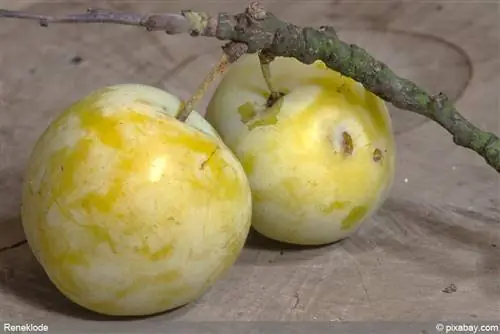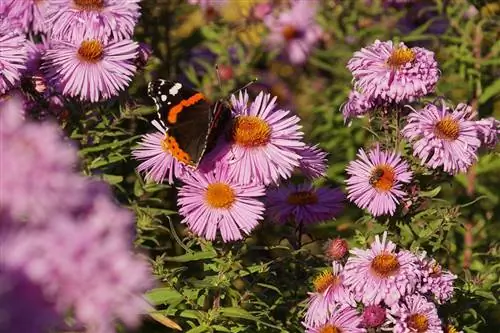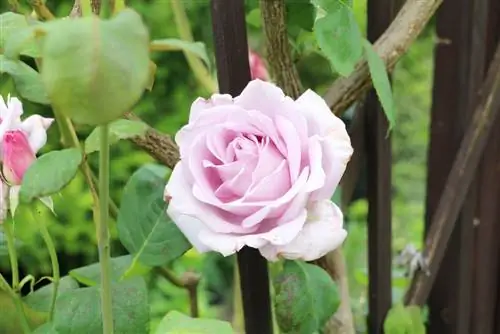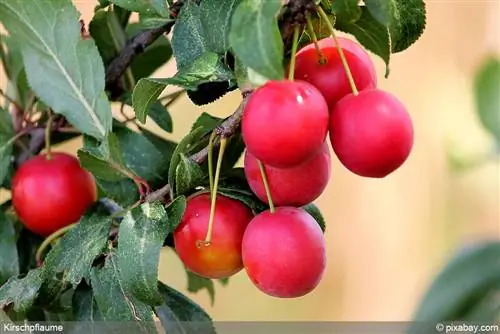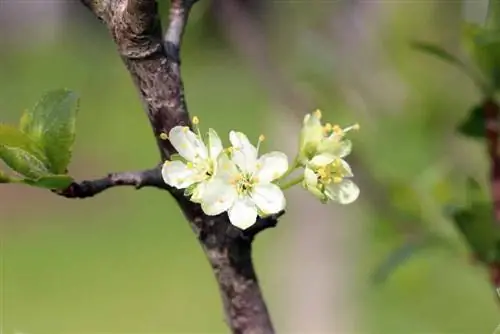- Author admin [email protected].
- Public 2023-12-17 03:39.
- Last modified 2025-01-24 12:45.
The sweet plum is divided into two types. Varieties with red to blue fruits and a slightly bitter taste and the Reneklode, whose sweet fruits are yellow-green. In any case, the plums are almost spherical and have a small notch running through them. They taste good fresh from the tree but also as fruit puree, jam or on fruit cake and enrich the garden even while they are blooming. However, for abundant flowering and a large yield, a few points must be taken into account when caring for them.
Location
The sweet plum likes it warm and sunny and is not completely frost hardy. It should therefore be given a location where it receives plenty of sunlight and is also protected from cold winds. Depressions in which cold air can collect are unsuitable. Slight elevations and proximity to walls or walls are ideal. It is best if the tree faces south.
Substrate
The soil for the sweet plum should be nutrient-rich, heavy and clayey. Moist clay soil with a neutral to slightly acidic pH value of 6 to 6.5 is well suited. If the garden soil does not meet these requirements, it can be mixed accordingly with compost and clay powder. If the pH value is too low, it can be brought into the correct range with lime.
Plants
Although the sweet plum is not completely frost hardy, it should be planted between autumn and spring. Early autumn is favorable, but any other frost-free day can also be chosen. It is recommended to prepare the substrate at least four weeks before planting. This allows the nutrients to settle and distribute. After planting, it is watered thoroughly to stimulate root formation and growth.
Pouring
The substrate should always be slightly moist, because the Reneclode cannot tolerate prolonged dryness. However, waterlogging is also harmful to the plant. After growing, it is therefore advisable to only water the plum in phases with little rainfall. Soft water is not absolutely necessary. Tap water with a slightly higher lime content is also sufficient.
Fertilize

In terms of nutrients, the sweet plum is quite undemanding. It is sufficient to supply the tree with a nitrogen-rich complete fertilizer every two to three years. Alternatively, some compost can be placed on the tree disc and lightly worked into the soil. Afterwards, you should water well so that the nutrients can be distributed well. The right time is spring, when the sweet plum is already showing new shoots.
Blend
The most complex care measure for the sweet plum is the trimming - but this is also comparatively easy. Immediately after planting, the crown is shortened by about a third. In the spring, before the first shoots appear, the crown is thinned out from the second location. The following will be removed:
- crossing branches
- Shooters that grow parallel to the main trunk
- bare, old branches
The crown can also be reduced to four to five main branches. If you find it difficult to see where you should cut and what should be left on the tree, you can make up the cuttings in the summer or mark the corresponding shoots. This time is of course recommended after the fruit has been harvested, otherwise many of the renoclodes would be lost. However, the trimming should really be done every year so that the tree is not overloaded.
Important when it comes to waste
- use clean and sharp cutting tools to prevent infection
- Use a wound closure for larger branches to prevent pests and germs from entering
- Saw larger branches first from below and only then from above to prevent the bark from breaking off and being torn out
- Carry out cuttings on dry days and in the morning so that the cuts can dry
Support branches
You can already see how many fruits the branches will later be burdened with by looking at the rich blossoms of sweet plums and renecludes. Although these are rather small, they occur in large numbers and therefore have a high overall weight. The branches can break underneath this, sometimes causing large wounds on the tree. It therefore makes sense to support the respective branches if necessary and, if necessary, shorten them afterwards in order to prevent them from being overloaded again. To do this, two to three sturdy rods are inserted into the ground and the upper ends are connected so that the branch can be placed on them and attached to them.
Harvest
Depending on the variety, the ripeness of the fruits can be recognized by their color. Reneclodes become yellowish. Depending on the variety, plums are red or blue. The harvest maturity can of course also be checked by taste. In addition, ripe fruits are very easy to pick from the tree. If some shoots have to be cut anyway due to the risk of breakage, the harvest can be directly linked to this care measure. However, due to the different levels of ripeness, it is advisable to leave the fruits on the tree a little longer and use them for preserving.
Storage
The fresh fruit will keep in the fridge for a few days. If the yield is very large, not all of the fruit can often be eaten fresh. However, washed, pitted and pureed, they are optimally prepared for freezing as fruit puree. The pitted fruits can also be boiled whole or halved. This works in mason jars with a rubber seal and clips, even without sugar. The plums are simply filled into the jars with a little water and then boiled in a water bath or in the oven. The third alternative is to prepare jam and preserves. Cooked with a gelling agent, filled into jars and boiled, the plums and reindeer can be enjoyed all year round.
Wintering
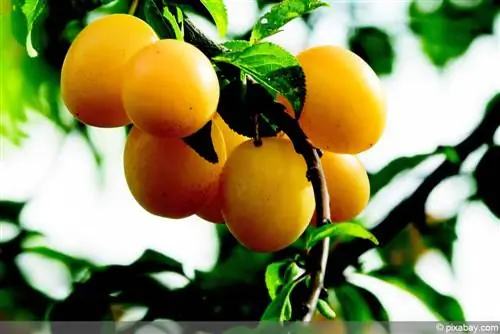
As already mentioned, the sweet plum is not completely frost hardy. It should therefore be protected accordingly in harsh winters. A layer of brushwood, straw and mulch as well as a layer of garden fleece on the crown and around the trunk protects against the effects of severe frost. If the sweet plum is initially cultivated in a pot, the planter should be moved to a cool but frost-free place. Light is not absolutely necessary for overwintering in this way. However, care should be taken to ensure that the substrate does not dry out completely. Occasional and sparing watering is sufficient for this purpose. This is also recommended outdoors when it is neither snowing nor raining. However, winter watering should only be done on frost-free days in the morning if possible.
Care errors, diseases and parasites
A viral infection called Schakra disease and a fungal infection known as Monilia tip drought occasionally occur on sweet plums. Chakra disease can be recognized by:
- Ring or dot-shaped discolorations on the leaves that can be light green to black
- sunken discoloration on the fruit with rubbery, different-colored flesh underneath
- previous aphid infestation that transmits the virus
- numerous falling fruits
The disease is combated by removing and destroying affected sections right down to the he althy wood as quickly and thoroughly as possible. Due to the risk of infection, infected clippings must not be composted or chopped. If the infestation continues to spread, the entire tree may have to be felled if necessary.
As a preventive measure, resistant varieties can be chosen and beneficial insects can be used that eat aphids and thus reduce the risk of infection.
Monilia tip drought is a fungal infection that spreads primarily in poorly ventilated and therefore persistently moist crowns. It can be recognized by the fact that young shoot tips die off. As a preventive measure, the crown of the sweet plum should always be kept light and airy through regular trimming. This allows it to dry well and reduces the risk of fungal spores spreading. If the disease already exists, the affected shoots are cut back at least 20 centimeters deep into the he althy wood. In addition, an appropriate fungicide should be used to combat the spores. Here too, the clippings must be destroyed in order to prevent renewed spread and infection.
Conclusion
The noble plum or Reneklode is a very simple and easy-care fruit tree that attracts with delicious fruits in abundance and, when cultivated correctly, produces them reliably year after year. Some effort should only be put into choosing the location and substrate as well as the cuttings. This lays the foundation for a rich yield.

